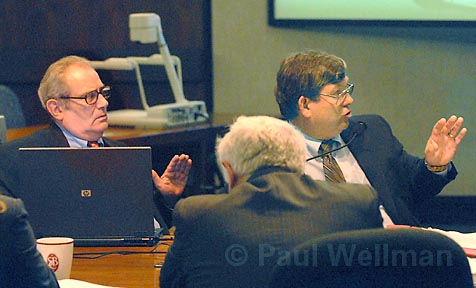S.B. Resists Housing Mandate
County vs. State?

At their meeting on Thursday, August 16, Santa Barbara County Association of Governments (SBCAG) boardmembers chose not to accept the housing mandate forced upon them by the state but rather sought to modify it in a way that could lessen or eliminate the number of units the state says the county needs. While SBCAG officials-the board consists of the five county supervisors, along with a representative from each of the county’s incorporated cities-intend to look at all administrative possibilities first, the option of a lawsuit to contest the mandate has not been ruled out.
The state has issued the mandate as a means of addressing California’s housing problem. The California Department of Housing and Community Development (HCD) crafts a Regional Housing Needs Allocation (RHNA) for regional agencies such as SBCAG, which then divides up that number as requirements for each city and county. An RHNA for SBCAG was last developed in 2002. Of the nine jurisdictions throughout the county, only Goleta was found to be out of compliance with the state.
Two SBCAG members-Carpinteria City Councilmember Joe Armendariz and Lompoc Mayor Dick DeWees-voted at the group’s Thursday meeting for SBCAG to opt out of the RHNA process, opening it to whatever legal consequences, if any, may result. “We don’t want a revised allocation,” Armendariz said. “We don’t want an allocation at all.” The remaining boardmembers voted to go back to HCD and request a revised allocation based on a genuine consultation from the state during which SBCAG could present information from its new forecast that would paint a more realistic picture of what the county’s housing situation really is. Many boardmembers said that the county cannot justifiably be forced to accommodate 13,312 new housing units between now and 2014 when San Luis Obispo County was asked to implement only 4,885 units in the same period. SBCAG Executive Director Jim Kemp argued this point in an August 8 letter to Linda Wheaton, the HCD assistant deputy director. Additionally, he requested additional time to review the draft allocation and for a true consultation with HCD officials.
At its August 21 meeting, the county Board of Supervisors also discussed the matter of the state housing mandates. Various members expressed concern that local control is lacking in determining local housing needs. “We’re not defying the state,” said 5th District Supervisor Joe Centeno. “We have every right to question what they’re doing to us. At what point do we say, ‘We can’t grow anymore’?” Centeno said state officials are too far removed to impose fair mandates.
County Counsel Shane Stark and Senior Deputy County Counsel David Allen read a list of 24 cities or counties that have been involved in litigation regarding state housing mandates. Three jurisdictions have been successful in defending against housing law litigation, Allen said, but none has prevailed using the argument that they don’t need to comply with state law.
Many speakers in the audience suggested the mandate could be ignored. Others suggested that a trip to the courtroom might be okay either way. “Sometimes it’s not bad to have a judge decide something, win or lose,” said Andy Caldwell, executive director of COLAB (Coalition of Labor, Agriculture, and Business). At the supervisors’ request, county staff will look into how the mandate interacts with the issue of the limitations of public infrastructure. But the million-dollar question continues to be the legality of it all. Asked 3rd District Supervisor Brooks Firestone, “We take an oath of office. And in that oath of office we swear to uphold the laws of California, is that not correct?”



